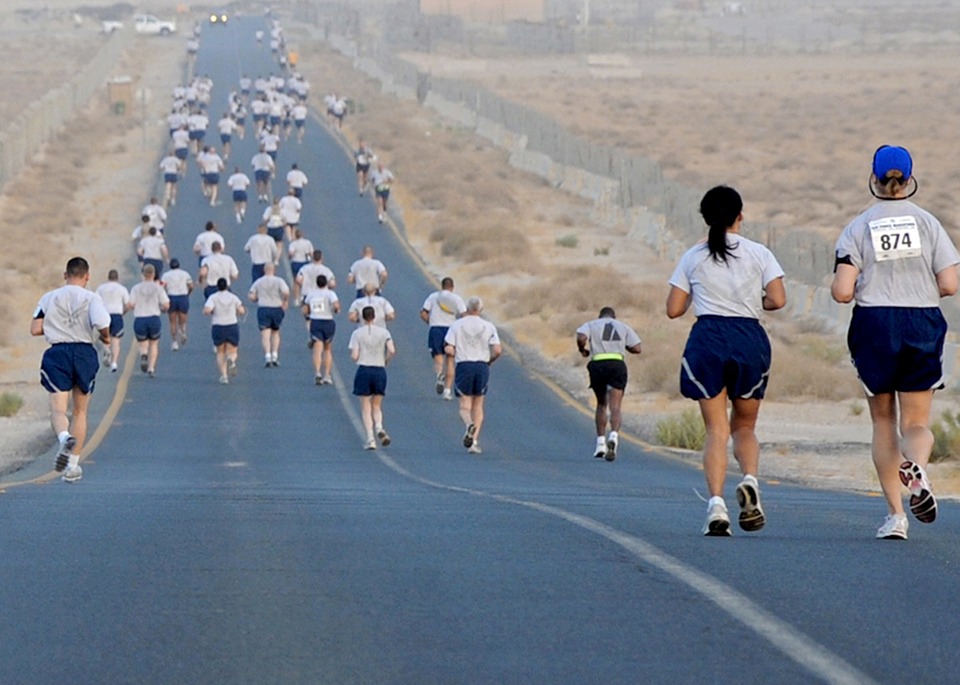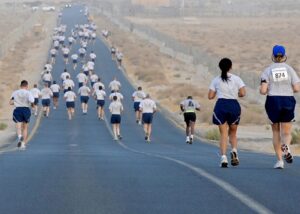
Five Resistance Training Myths in the Running World
To some, resistance training is the Rodney Dangerfield of the running community; it gets no respect. To others, it’s like Tom Cruise; runners think it might be useful, but it just doesn’t make any sense to them. And then, there are those to whom resistance training is like Abraham Lincoln; it’s freed them from being slaves to ineffective programming.
As a performance enhancement specialist who has a lot of “Abe” endurance athletes under my tutelage, I’d like to take this opportunity to bring the Rodney and Tom runners in the crowd up to speed. With that in mind, let’s look at the five most prominent myths present in the running community with respect to resistance training.
Now, I know what you’re thinking: this Cressey guy is just another meathead who doesn’t run telling me what to do. We’ve had lots of pigheaded guys like this over the years, and none of them understood us. They were all like this guy.
Myth #1: Runners don’t need to resistance train.
I figured I’d start with the most obvious of the bunch. I had been under the impression that – now that we’ve done a ton of resistance training research over the past 20 years – that this wasn’t still a myth at all. Then, just last month, one of my marathoner clients brought in a copy of a popular running magazine; it included a “debate” that featured two experts arguing over whether or not runners needed to lift weights.
Huh?
This is what some people within the running community have taken from over two decades of dedicated resistance training research from some of the most brilliant scientists in the world? I thought back to the hundreds of hours I’d spent working in the human performance laboratory at the University of Connecticut as I worked for my master’s degree; time and time again, our research had proven unequivocally that resistance training was important for making and keeping people healthy, strong, fast, and lean. Had all our efforts been in vain? At that moment, if someone had told me that the Easter Bunny isn’t real, I might have lost it altogether.
Just to recap: we know resistance training is good for general health, as it:
1. Enhances endocrine and immune function (which are compromised by endurance training)
2. Maintains muscle mass (also negatively affected by endurance training)
3. Improves functional capacity in spite of aging by maintaining maximal strength and power (both of which decrease with prolonged endurance training)
4. Builds bone density (something many runners lack due to poor dietary practices, but desperately need in light of the high risk of stress fractures)
5. Enables us to more rapidly correct muscle imbalances, as evidenced by the fact that resistance training is the cornerstone of any good physical therapy program (and I’ve never met a runner without imbalances)
So, I think that the answer is somewhat clear. It’s quite obvious that runners are a superhuman race that is not subject to the normal laws of physiology like the rest of us.
In case you’re not picking up on my sarcasm, please go splash some cold water on your face and knock back a bit of Gatorade to get some glucose to your brain. Then, reread those five points from above (which are just the tip of the iceberg, for the record). Ask yourself:
1. Do I have an endocrine system?
2. Do I have an immune system?
3. Will I get old? Do I do things that require strength and power?
4. Do I have bones?
5. Do I have muscle imbalances?
If you answered “no” to any of these questions, I would seriously recommend that you consult a psychologist instead of a running coach, as you’re obviously dealing with a serious case of denial.
Runners are just like the rest of us. You may wear shorter shorts, but you still put them on one leg at a time. You need resistance training.
And, if the general health benefits aren’t enough, consider these research findings:
-A University of Alabama meta-analysis of the endurance training scientific literature revealed that 10 weeks of resistance training in trained distance runners improves running economy by 8-10% (1). For the mathematicians in the crowd, that’s about 20-24 minutes off a four-hour marathon – and likely more if you’re not a well-trained endurance athlete in the first place.

-French researchers found that the addition of two weight-training sessions per week for 14 weeks significantly increased maximal strength and running economy while maintaining peak power in triathletes. Meanwhile, the control group – which only did endurance training – gained no maximal strength or running economy, and their peak power actually decreased (who do you think would win that all-out sprint at the finish line?). And, interestingly, the combined endurance with resistance training group saw greater increases in VO2max over the course of the intervention (2).
-Scientists at the Research Institute for Olympic Sports at the University of Jyvaskyla in Finland found that replacing 32% of regular endurance training volume with explosive resistance training for nine weeks improved 5km times, running economy, VO2max, maximal 20m speed, and performance on a 5-jump test. With the exception of VO2max, none of these measures improved in the control group that just did endurance training (3). How do you think they felt knowing that a good 1/3 of their entire training volume was largely unnecessary, and would have been better spent on other initiatives?
-University of Illinois researchers found that addition of three resistance training sessions for ten weeks improved short-term endurance performance by 11% and 13% during cycling and running, respectively. Additionally, the researchers noted that “long-term cycling to exhaustion at 80% VO2max increased from 71 to 85 min after the addition of strength training” (4)
The take-home message is that running is more than just VO2max, anaerobic threshold, and a good pair of sneakers; it’s also about localized muscular endurance and nervous system efficiency. And, you can’t have strength endurance unless you’ve got strength. Build a solid foundation and you’ll be a complete runner.
Myth #2: Machines are just as good as free weights.
Next time you’re running, I want you to ask yourself how many times you’ve been seated and moving in a fixed plane of motion while you run. If the answer isn’t a resounding “NEVER,” then you probably ought to get your head examined.
Resistance training isn’t just about “feeling the burn” in your muscles; it’s about grooving connections between the muscles and the nervous system that tells them what to do. When you plop down on a machine and work through a fixed line of motion, you’re allowing your nervous system to get lazy, so to speak; it doesn’t have to recruit any stabilizing muscles to ensure that you move efficiently. Machines turn you into a “motor moron” and ingrain muscle imbalances that can negatively affect your running efficiency and lead to injury. Let’s take a look at an example to illustrate my point.
When you do a dumbbell lunge, your body has to generate force in single-leg stance – and in order to generate force optimally, you need to have what is called “frontal plane stability.” With the lunge, this refers predominantly to the ability of the adductors (inner thigh muscles) and abductors (outer thigh/butt muscles) to co-contract, working together stabilize your thigh so that you don’t tip over. By doing a lung correctly, we can teach these muscles to balance each other out properly, and in doing so, improve running efficiency and prevent problems such as lateral knee pain, anterior hip pain, and lower back pain (just to name a few).
A look at the status quo, however, shows that most women will try to train their adductors a
nd abductors with those inner and outer thigh machines that you’d only expect to see on a trip to the obstetrician. Unfortunately, the adductors and abductors NEVER work in isolation like this, and they never work in a fixed line of motion. The adductors and abductors don’t just move the thighs in and out; they also have subtle effects on rotation of the femur, so when we’re “stuck” into one plane of motion, we promote dysfunction.
Factor in that the lunge also trains the hamstrings, glutes, quadriceps, and core stabilizers extensively at the same time, and you’ll realize that it isn’t only safer than these machines; it’s also offers more bang for your buck. Why do five different exercises when you can get even better results with just one?
Myth #3: Yoga and Pilates “count” as resistance training.
This was another great information tidbit a client brought in after a conversation with an endurance training coach who is actually quite popular locally. I have to say that I was really surprised when I heard:
“He said that we need to resistance train, but it didn’t matter if we used free weights, used machines, or took yoga or Pilates classes.”
After I finished choking on the gum I was chewing, I explained the concept of progressive overload to my client.
When we resistance train, it’s important that we – over time – gradually increase the load that is imposed on our system; otherwise, our body doesn’t really have any reason to adapt in a manner that will be favorable to use getting stronger, faster, or leaner.
Now, how do we make a class that is body weight-only harder? I’ve never seen anyone wear a weighted vest to yoga class, so – as Mike Boyle has pointed out – gaining weight is your only option. After all, the most overweight people always sweat the most during yoga, right?
Obviously, I’m being facetious – but I’m proud to say that it’s with good reason (although I’ll probably never date a yoga or Pilates instructor after this article). When you lift with free weights, you always have the option to provide progressive overload to your system; there is no “ceiling” effect when you get proficient handling your body weight.
Myth #4: Super-slow training is valuable.
About a year ago, I had a phone conversation with a noted triathlete coach who had previously worked with one of my clients, Jon (who completed his first Ironman this past July). When I took over Jon’s training, he was a mediocre endurance athlete with a VO2max of 50.6 ml/kg/min., with anaerobic threshold occurring at 60% of VO2max (laboratory test). After six months of training with me, Jon’s VO2max had improved to 73.1 ml/kg/min, and his anaerobic threshold didn’t occur until an impressive 80% (anaerobic threshold is now generally believed to be the best predictor of endurance performance; the higher the percentage, the better). It’s also important to note that during this time, Jon’s max heart rate remained constant; normally, it decreases when an endurance athlete does a lot of longer duration steady-state training. When this coach got wind of the results, he just had to know how the heck we had gotten such staggering results. My response was essentially:
“We got him to go faster instead of longer, incorporating more threshold runs and sprint work. And, probably more importantly, I told him he had to stop lifting like a sissy. He got a lot stronger and more explosive on compound free-weight movements, and it clearly made a big difference.”
His response: “Wait, you mean you don’t use super-slow training? Free weights are dangerous! Endurance athletes aren’t conditioned to handle high-speeds and heavy lifting!”
I had to cover the mouthpiece on the phone because I was laughing out loud. For the next ten minutes, I explained to this coach that the last time I checked, the most successful endurance athletes I’ve known are the ones who go the fastest for a set distance – not the ones who can run the longest. Anybody can go forever; just look at the people who jog at a snail’s pace for years and years and never look or perform any differently. Jon got out of his comfort zone by moving faster, desensitizing himself to zones above his normal race pace, and – perhaps most importantly – by taking his training serious with heavy and explosive resistance training. Super-slow training has no place in this picture.
In layman’s terms, if you train an athlete slowly, that athlete will be slow in competition; specificity of training is more important than we think. If you want to run a marathon, you don’t do all your training on a cycle, do you? Of course not! It wouldn’t be specific for you!

In scientific jargon, super-slow training doesn’t work due to a phenomenon called “asynchronous recruitment.” We all have slow twitch and fast twitch muscle fibers, and it’s to our advantage to activate as many of them as possible when we resistance train in order to truly reap the benefits that our nervous system and muscles can offer. As you may already know, slow twitch fibers are always recruited first; your body won’t also call upon the fast twitch fibers in your muscles unless it really needs help with a challenging task – like the last few reps on a set of five squats. Once we’re a bit experienced with resistance training, in order to recruit fast twitch fibers (which can actually be converted to slow twitch fibers to enhance endurance performance), we need to train with at least 70% of our maximal strength on a particular exercise in order to build strength with classic “repetition work.” The more experienced one gets, the higher this percentage goes; really experienced lifters won’t get stronger below 85-90%, in fact.
With super-slow, we’re stuck with a protocol that forces us to use less weights because we have to do a lot of reps – and at a very slow tempo. This load falls short of the crucial 70% mark – and definitely far short of the 85-90% mark. And, believe it or not, we don’t even getting all our slow twitch fibers contributing! Instead, through asynchronous recruitment, certain fibers simply “turn on” and “turn off” during the set; the weight is so light that they can actually take breaks while their “helpers” pick up the slack in the meantime. I’m not making this stuff up!
Don’t forget that super-slow is traditionally performed on machines, too, and we already know that machines are about as useful to an athlete as a screen door would be for a submarine.
Myth #5: Runners should avoid heavy weights and dynamic lifts.
Once we get endurance athletes lifting weights, we always have to deal with the contention that because they’re endurance athletes, they should only do higher-rep sets because they just need to train muscular endurance. Originally, that works fine, as you’re really just learning the exercises and conditioning the tissues for what is ahead. Unfortunately, as the athlete gets more experienced with resistance training, it becomes readily apparent that not all reps are created equal.
There are three ways that we can develop tension in our muscles (basically the goal of any resistance training exercise):
1. The Repetition Method – This is the classic approach most gym-goers use. Do a bunch of reps, and as you fatigue, the muscle tension accumulates; the last few reps are what make the big difference.
2. The Maximal Effort Method – This is an approach where the load utilized is heavier, so the tension is “automatically” applied to the muscles. You just have to work against it. This method – which uses rep ranges of 1-6 – is great for building muscular strength and teaching your nervous system to recruit more muscle fibers.
3. The Dynamic Effort Method – This approach uses non-maximal loads, but
the focus is on lifting the weight as fast as possible. Jump squats are a good example of dynamic effort training, which teaches the nervous system to recruit muscles faster. Additionally, some dynamic effort training can teach your tendons to store more elastic energy (like plyometrics). If your tendons work more efficiently, your running style is more relaxed, reflexive, and “springy,” as you don’t have to “muscle” every stride.
With all this said, it should become clear that you can’t pursue the maximal or dynamic effort methods with sets of 12-15; you have to use different rep ranges and loading parameters if you want a truly effective resistance training program.
Frequently Asked Questions
Q: Won’t I gain body fat if I cut back my running volume and replace it with resistance training?
A: No! Contrary to popular belief, resistance training is extremely valuable for burning fat – primarily due to something known as “Excess Post-Exercise Oxygen Consumption” (EPOC). This is just a fancy way of saying that after any exercise session, our metabolisms are elevated significantly. Research has shown that EPOC directly related to how intense our exercise sessions are; the more intense the effort, the more metabolic “debt” we accumulate. For this reason, activities like sprinting and weight-training – both of which are much more intense than steady-state jogging – have a ton of merit in “battling the bulge.” Amazingly, a single bout of resistance training can elevate the metabolism for more than 48 hours – and favorably affect endocrine and immune status in a manner that is conducive to fat loss. If you want to be lean, you have to lift weights!
Additionally, you rarely see ultra-endurance athletes with very low body fat percentages – and it’s largely because all the mileage they do leads to higher levels of cortisol and lower levels of testosterone in the body. This endocrine fluctuation leads to a loss of muscle mass (which burns a lot of calories) and an increased tendency to store body fat. Fortunately, resistance training has been shown to have favorable effect on testosterone levels chronically (good for men and women…trust me). By keeping your hormonal status in check by including some resistance training, runners can get faster and leaner!
Q: I have limited time to train; wouldn’t I be better off just running if time is limited?
A: Obviously, this would depend on how you define “limited” – but it’s been my experience that runners can always “make” time to run, but will only “try to find” time to resistance-train. Generally speaking, you can bang out a run here and there without much time preparation, so it’s best to schedule your 2-3 resistance training sessions ahead of time. Additionally, in some cases, you can incorporate some body weight resistance training exercises as part of your warm-up – but this certainly won’t cover all your needs.

Also, don’t forget the study I cited earlier about the group of endurance athletes who saw appreciable gains in performance by replacing 32% of their running volume with resistance training. If you run six days a week, try moving to four runs and two lifting sessions – and watch your times improve dramatically.
Anyway, my feeling is that from a body composition, health, and performance standpoint, you need to make time for two lifting sessions per week regardless of how much you run.
Q: Won’t resistance training will interfere with my running?
A: Great question – and the answer is no, provided you schedule your running sessions appropriately. Ideally, you would lift on days that you don’t run, or pair your lifts up with your tempo (sprint) sessions in order to “consolidate” your most intense training and allow for better recovery.
There is some research to show that running efficiency is impaired slightly for up to eight hours post-exercise, but you should be fine if you lift and run on separate days. I always prefer that my athletes lift before they run, though; you always want to do your speed and power work before you move on to endurance training.
Q: Won’t resistance training make my muscles bigger? I don’t want all that weight holding me down!
A: Endurance training by its very nature is not conducive to muscle growth (especially in a female population with lower testosterone levels). The sheer volume of exercise makes it difficult to get in enough calories to support muscle mass gains, so the effects of resistance training are largely confined to muscle density (tone), strength, and overall efficiency rather than actual increases in muscle size. If it was so easy to get “bulky,” there would be a lot more bulky people walking around!
Closing Thoughts
All this information won’t be of any use if it isn’t put into action, so now is the time to either modify how you’re lifting, or start lifting in the first place. At the very least, you need to complement your endurance training with two resistance-training sessions per week – and preferably three.
Just as running is more fun with a partner, so is lifting, so find a few buddies to hit the gym with you. In our facility, time and time again, we’ve seen athletes make much better progress when they’re training in small groups and pushing each other to get better. Plus, for those of you who might be a bit intimidated at the thought of joining a gym, some training partners can do a lot to ease your worries.
At your fingertips, you have an opportunity to dramatically improve performance, overall health, and the way your body looks and feels. There’s no time like the present to turn that opportunity into a reality.
References
1. Jung AP. The impact of resistance training on distance running performance. Sports Med. 2003;33(7):539-52.
2. Millet, GP, Jaouen, B, Borrani, F, Candau, R. Effects of concurrent endurance and strength training on running economy and .VO(2) kinetics. Med Sci Sports Exerc. 2002 Aug;34(8):1351-9.
3. Paavolainen, L, Hakkinen, K, Hamalainen, I, Nummela, A, Ruski, H. Explosive-strength training improves 5-km running time by improving running economy and muscle power. J Appl Physiol. 1999 May;86(5):1527-33.
4. Hickson, R. C., B. A. Dvorak, E. M. Gorostiaga, T. T. Kurowski, and C. Foster. Potential for strength and endurance training to amplify endurance performance. J. Appl. Physiol. 65: 2285-2290, 1988.



